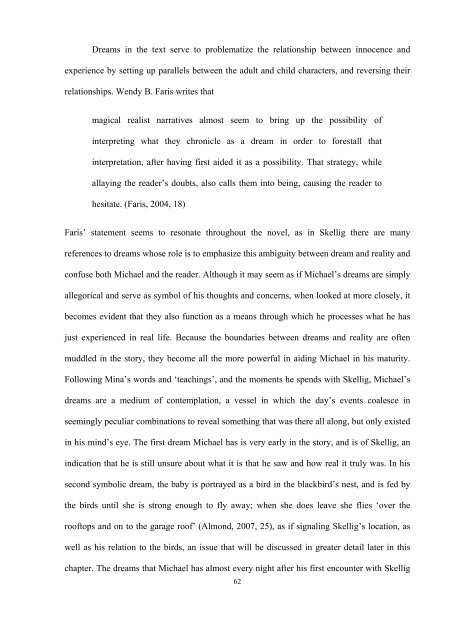The secular angel in contemporary children's literature: David ...
The secular angel in contemporary children's literature: David ...
The secular angel in contemporary children's literature: David ...
You also want an ePaper? Increase the reach of your titles
YUMPU automatically turns print PDFs into web optimized ePapers that Google loves.
Dreams <strong>in</strong> the text serve to problematize the relationship between <strong>in</strong>nocence and<br />
experience by sett<strong>in</strong>g up parallels between the adult and child characters, and revers<strong>in</strong>g their<br />
relationships. Wendy B. Faris writes that<br />
magical realist narratives almost seem to br<strong>in</strong>g up the possibility of<br />
<strong>in</strong>terpret<strong>in</strong>g what they chronicle as a dream <strong>in</strong> order to forestall that<br />
<strong>in</strong>terpretation, after hav<strong>in</strong>g first aided it as a possibility. That strategy, while<br />
allay<strong>in</strong>g the reader’s doubts, also calls them <strong>in</strong>to be<strong>in</strong>g, caus<strong>in</strong>g the reader to<br />
hesitate. (Faris, 2004, 18)<br />
Faris’ statement seems to resonate throughout the novel, as <strong>in</strong> Skellig there are many<br />
references to dreams whose role is to emphasize this ambiguity between dream and reality and<br />
confuse both Michael and the reader. Although it may seem as if Michael’s dreams are simply<br />
allegorical and serve as symbol of his thoughts and concerns, when looked at more closely, it<br />
becomes evident that they also function as a means through which he processes what he has<br />
just experienced <strong>in</strong> real life. Because the boundaries between dreams and reality are often<br />
muddled <strong>in</strong> the story, they become all the more powerful <strong>in</strong> aid<strong>in</strong>g Michael <strong>in</strong> his maturity.<br />
Follow<strong>in</strong>g M<strong>in</strong>a’s words and ‘teach<strong>in</strong>gs’, and the moments he spends with Skellig, Michael’s<br />
dreams are a medium of contemplation, a vessel <strong>in</strong> which the day’s events coalesce <strong>in</strong><br />
seem<strong>in</strong>gly peculiar comb<strong>in</strong>ations to reveal someth<strong>in</strong>g that was there all along, but only existed<br />
<strong>in</strong> his m<strong>in</strong>d’s eye. <strong>The</strong> first dream Michael has is very early <strong>in</strong> the story, and is of Skellig, an<br />
<strong>in</strong>dication that he is still unsure about what it is that he saw and how real it truly was. In his<br />
second symbolic dream, the baby is portrayed as a bird <strong>in</strong> the blackbird’s nest, and is fed by<br />
the birds until she is strong enough to fly away; when she does leave she flies ‘over the<br />
rooftops and on to the garage roof’ (Almond, 2007, 25), as if signal<strong>in</strong>g Skellig’s location, as<br />
well as his relation to the birds, an issue that will be discussed <strong>in</strong> greater detail later <strong>in</strong> this<br />
chapter. <strong>The</strong> dreams that Michael has almost every night after his first encounter with Skellig<br />
62
















